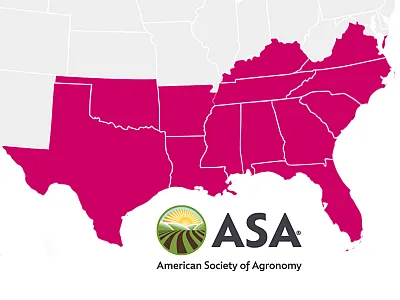What Is a 4R Plant Nutrient?

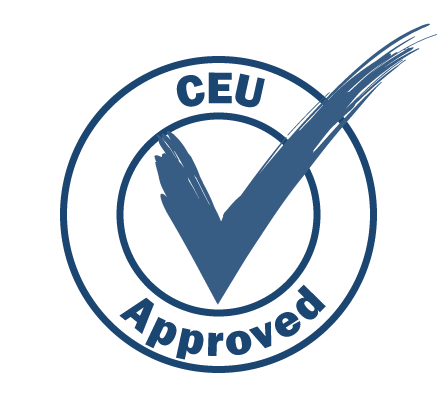
What is a plant nutrient? For many decades, plant nutrients have been defined by the concept of essentiality. More recently, however, 4R nutrient stewardship has been defined as management that produces sustainable outcomes. Some elements provide benefits even if they are not essential. A new definition of what a plant nutrient is has been proposed and is under consideration by authorities in fertilizer regulation. Earn 1 CEU in Nutrient Management by reading this article and taking the quiz.
What is a plant nutrient? This question is important to 4R plant nutrition because it is important to include all plant foods that can be applied to improve the outcomes of nutrient stewardship.
For many decades, plant nutrients have been defined by the concept of essentiality. A mineral element was declared essential once science proved that in its absence, a plant could not complete its life cycle, and no other nutrient could substitute for it. In some jurisdictions, authorities required this proof of essentiality for nutrient claims in products sold as fertilizers.
More recently, however, 4R nutrient stewardship has been defined as management that produces sustainable outcomes, which suggests that it is the outcomes of applying the material, not its essentiality, that govern the questions, “What is the right source to apply?” and “What is a plant nutrient?” Some elements provide benefits even if they are not essential. Current classifications of essential and beneficial plant nutrient elements are outlined in Table 1.
Considering the foregoing, a new definition of what a plant nutrient is has been proposed and is under consideration by authorities in fertilizer regulation, including the Association of American Plant Food Control Officials (AAPFCO) and the International Standards Organization (ISO). The new definition proposes that “A mineral plant nutrient is an element which isessential or beneficialfor plant growth and development or the quality attributes of the harvested product of a given plant species grown in its natural or cultivated environment” (Brown et al., 2022).
Whether a beneficial or essential nutrient, 4R nutrient stewardship practices should considered with every nutrient. The principles of 4R nutrient stewardship support the aims of responsible plant nutrition. Five such aims have recently been outlined, and they correspond with areas in which crop production can be made more sustainable (Figure 1; SPRPN, 2020). The five aims include: (1) improving productivity, income, efficiency, and resilience; (2) increasing nutrient recovery and recycling from waste; (3) lifting and sustaining soil health and soil carbon; (4) enhancing human health through nutrition‐sensitive agriculture; and (5) minimizing losses related to greenhouse gases, pollution of water and air, and biodiversity. Many nutrients contribute to achieving each aim, but some aims may need more particular nutrients. We will discuss each aim in turn and their dependence on nutrients.
1. Improving Productivity, Income, Efficiency, and Resilience
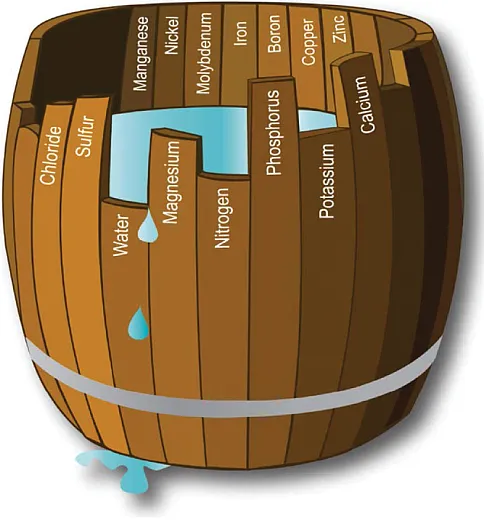
The first aim addresses productivity and its resulting benefits to income for growers while increasing efficiency and resilience. At least 30 to 50% of crop yield is attributable to commercial fertilizer nutrient inputs (Stewart et al., 2005). This means that the efficiency of crop production per unit of land and per unit of other fixed inputs is increased by 40 to 100%. Net income can thus be more than doubled, provided fertilizers are applied using the right source, right rate, right timing, and the right placement. The nutrients most frequently limiting yield are nitrogen (N), phosphorus (P), and potassium (K) with sulfur (S) and micronutrients increasingly playing important roles as well (Flis & Jones, 2020).
The “Law of the Minimum” means that any nutrient can limit yield and the use efficiency of other nutrients (Figure 2). Sound diagnosis of the soil and past crops is an important part of any 4R nutrient plan. This means continued testing to determine whether any nutrient may contribute to yield improvement. The new definition of plant nutrient opens greater opportunity for adaptive research and adaptive management within 4R programs.
It’s not easy to find hard numbers for resilience, but it seems logical to argue that creating balanced nutrient levels in soils contributes to improving it. University and Extension typically encourage growers to maintain soils at a “medium” or optimum soil test level for P and K and other nutrients. At an optimum level, the soil provides most of the nutrient to the crop, and the purpose of fertilizing is replenishing the soil rather than directly boosting yield. There is thus more flexibility in “right rate,” and growers can adjust for changing prices of fertilizers and crops as well as suffer less yield loss if weather conditions prevent timely application.
Building balanced nutrient levels will lead to healthy, resilient soils and greater productivity and profitability for growers. Both essential and beneficial nutrients can contribute to this balance under the 4R nutrient stewardship framework.
2. Increasing Nutrient Recovery and Recycling From Waste
As the human population expands, the depletion of the resources used to make fertilizers and the accumulation of wastes in soils and the natural environment have become important concerns. Both concerns can be mitigated by recycling where possible. The biggest opportunity for N, P, and K is by improving the management of manure. As indicated by the nutrient balances in NuGIS (TFI, 2023), the differences between the amounts excreted by livestock and the recovered amounts applied to cropland are large. Since manures are bulky and difficult to transport, technologies to extract nutrients in forms similar to fertilizer are needed to improve the overall utilization of the nutrients.
There are also opportunities to recapture N further down the value chain, by capturing it in wastewater treatment to produce biosolids. Most of these wastes that contain N and P also contain other important nutrients, including S, and micronutrients, especially zinc (Zn). “High quality biosolids and similar materials may be used beneficially in sustainable agriculture” (Chaney, 1994) if risks of excesses of arsenic, cadmium, copper, molybdenum, and selenium are managed (Chaney, 2012).
Recovery of struvite from wastewater is increasingly being used to produce an ammonium magnesium phosphate fertilizer with an analysis of 5‐28‐0‐10Mg in a granular form suitable for blending with other common fertilizers. In Pennsylvania, centrifuge extraction of P from dairy manure was shown to be economically feasible if the other nutrients extracted and environmental benefits were valued (Rotz et al., 2022).
The various nutrient extraction technologies facilitate increased recycling of nutrients—both essential and beneficial—within the agri‐food system, and we can expect to see more of them in the future.
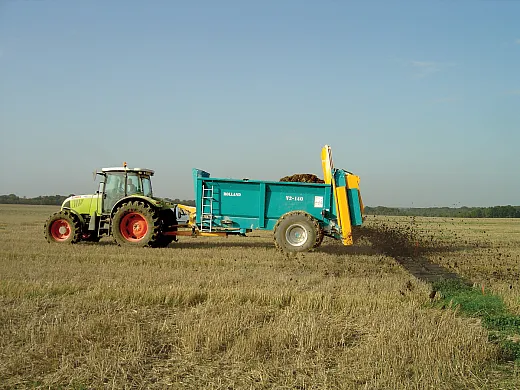
3. Lifting and Sustaining Soil Health and Soil Carbon
The use of 4R practices to manage nutrients is critical to support crop photosynthesis and make soil carbon storage an effective proposition for greenhouse gas mitigation. What is required is a delicate balancing act. Increasing primary productivity on cropland, reducing wastes, selecting climate‐smart nutrient sources, and using inhibitors to manage nitrous oxide emissions are all critical. Nitrogen inputs in particular play a large role in increasing soil organic carbon in the temperate soils of North America (Alvarez, 2005). Phosphorus can also be important. A recent meta‐analysis of 116 peer‐reviewed papers showed that the addition of P fertilizer generally increases total N in soils with higher biological retention, lower N losses, and increased soil carbon levels (Wang, 2022). The meta‐analysis shows the important link among P, N, and C in maintaining resilient and healthy soils.
The strong role of N and other nutrients in the multiple mechanisms of soil carbon storage underscores the need for integrated consideration of 4R nutrient management in programs that address both the emissions and sinks associated with cropping systems while keeping them productive (Bruulsema, 2022). Improving the carbon footprint of crop production requires simultaneous attention to three areas at once: soil carbon, nitrous oxide emission, and N use efficiency.
Beyond soil carbon, nutrient inputs play an important role in replenishing soil fertility, another important aspect of soil health. The status of soil pH, P, K, Mg, S, Zn, and Cl in North America is monitored through soil testing and has been reported on systematically every five years or so since 2001 (TFI, 2021b). Soil has capacity to retain nutrients, and regular soil testing helps ensure that soil fertility is maintained at an optimum level, important for both soil health and the resiliency of crop production systems.
4. Enhancing Human Health Through Nutrition‐Sensitive Agriculture
Nutrients enhance not only yield, but nutritional quality as well. Most plant nutrients are nutrients for animals and humans as well. The role of several micronutrients is particularly important for the alleviation of hidden hunger, which affects more than 2 billion people globally. Hidden hunger is most prevalent in the African continent and South Asia but is also increasingly reported in Europe and in North America. Children and women of reproductive age are most vulnerable (Stevens et al., 2022). Seven mineral nutrients (iron, zinc, copper, calcium, magnesium, selenium, and iodine) and several vitamins are often lacking in human diets (Van Der Straeten et al., 2020). Selenium and iodine have been added to fertilizers used in Finland and China, respectively, to improve human nutrition, even though these elements are not considered essential to plants and only rarely benefit crop yields.
Plant‐based foods provide 56% of the protein intake and 40–85% of various minerals to the global population (Smith et al., 2022). The remainder is supplied largely from products from animals that, in turn, were largely dependent upon plants for nutrition. So, getting the mineral nutrients into harvested crops is important. A global meta‐analysis of 67 studies found that fertilizing corn with Zn for yield improvement raised Zn concentration from 22 to 27 ppm, a 25% increase, but not enough to meet the 38 ppm target for alleviating human Zn deficiency (Mutambu at al., 2023).
Atmospheric CO2 is predicted to surpass 550 ppm in the next 30–80 years. Many food crops grown at 550 ppm show reductions of 3–17% in protein and Zn contents compared with current conditions. This could cause an additional 175 million people to be Zn deficient and an additional 122 million people to be protein deficient by the middle of this century (Smith & Myers, 2018). Crop nutrition strategies may need to change as a result.
Crop advisers need to pay attention to crop quality attributes in the assessment of 4R practices implemented on‐farm. Selection of appropriate cultivars and inclusion of micronutrients in applied fertilizers can enhance the concentration of these nutrients in harvested crops.
5. Minimizing Losses Related to Greenhouse Gases, Pollution of Water and Air, and Biodiversity
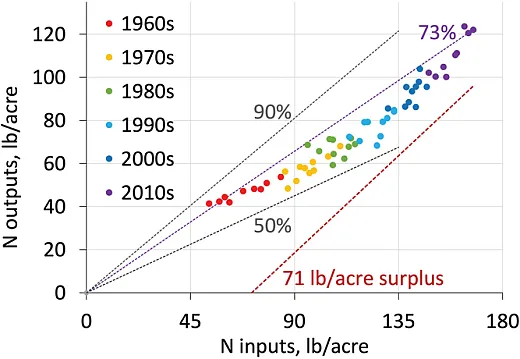
When it comes to impacts on the environment, two nutrients dominate the discussion. Phosphorus losses have been long known to impact water quality. Nitrogen losses affect not only water quality, but also air quality and greenhouse gas emissions. Improvement of nutrient use efficiency (NUE) goes a long way toward reducing these losses (SPRPN, 2023). Trends in NUE for North American crop production are improving or at least keeping up with increases in crop yields (as indicated in NuGIS in TFI [2021a] and in the cropland nutrient budgets of FAO [2022]), but further stewardship efforts are needed to keep nutrient surpluses to a minimum in intensified crop production.
The aggregate performance for North American crop production has encouraging trends. For the past few decades, both N use efficiency and N output per acre have been increasing (Figure 3). But some important caveats need to be kept in mind (Bruulsema, 2021):
- The large role of soybeans in the N balance hides the lower efficiency of other crops. As a N‐fixing species, soybeans and other legumes have high N use efficiency.
- Corn grain is lower in protein today compared with decades ago.
- As yields increase, higher levels of N use efficiency are needed to limit N surplus.
Biological N fixation involves cobalt, nickel, molybdenum, and sometimes vanadium, and thus these are required in greater amounts in N‐fixing species. Nickel is required in greater amounts when urea or ammonia are the dominant N source; Si is highly beneficial when Mn is present at toxic levels (Brown et al., 2022).
The challenge to continue improvements in N use efficiency is still relevant. It requires attention to all aspects of crop production, including 4R plant nutrition that includes consideration of all plant nutrients, essential and beneficial, for their potential to contribute.
Take‐Home Message
So, what is a 4R plant nutrient? It’s any nutrient that enhances plant growth and development or the quality attributes of the harvested crop products. These nutrients are all included in the aims of responsible plant nutrition. Paying attention to the nutrient composition of the harvested crop may be an important part of a 4R nutrient management plan, particularly when purchasers of crop commodities offer incentives.
References
AAPFCO. (2019). Product label guide. Association of American Plant Food Control Officials. https://www.rs.uky.edu/regulatory/fertilizer/label_guide_2019.pdf Alvarez, R. (2005). A review of nitrogen fertilizer and conservation tillage effects on soil organic carbon storage. Soil Use and Management, 21(1), 38–52. https://doi.org/10.1111/j.1475‐2743.2005.tb00105.x
Brown, P.H., Zhao, F.‐J., & Dobermann, A. (2022). What is a plant nutrient? Changing definitions to advance science and innovation in plant nutrition. Plant and Soil, 476(1), 11–23. https://doi.org/10.1007/s11104‐021‐05171‐w
Bruulsema, T. (2021). Nutrient stewardship: Taking 4R further. Crops & Soils Magazine, 55(1), 34–40. https://doi.org/10.1002/crso.20165
Bruulsema, T. (2022). Soil carbon needs 4R nutrients. Crops & Soils Magazine, 55(4), 34–38. https://doi.org/10.1002/crso.20203
Chaney R.L. (1994). Trace metal movement: Soil‐plant systems and bioavailability of biosolids‐applied metals. In C.E. Clapp, W.E. Larson, and R.H. Dowdy (Eds.), Sewage sludge: land utilization and the environment (pp. 27–31). SSSA. Chaney, R.L. (2012). Chapter two—Food safety issues for mineral and organic fertilizers. Advances in Agronomy, 117, 51–116. https://doi.org/10.1016/B978‐0‐12‐394278‐4.00002‐7
EU. (2019). Regulation (EU) 2019/1009 of the European Parliament and of the Council of 5 June 2019 laying down rules on the making available on the market of EU fertilising products. https://eur‐lex.europa.eu/homepage.html
FAO. (2022). FAOSTAT and IFA cropland nutrient budget database. http://www.fao.org/faostat/en/#data/ESB
Flis, S., & Jones, J. (2020). Sulfur 4R management and the changing landscape of fertility. Crops & Soils Magazine, 53(6), 19–22. https://doi.org/10.1002/crso.20074
Havlin, J., Tisdale, S., Nelson, W., & Beaton, J. (2013). Soil fertility and fertilizers: An introduction to nutrient management (8th edition). International Plant Nutrition Institute. (2019). Soil fertility manual. The Fertilizer Institute. ISO. (2022). International standards. Fertilizers, soil conditioners and beneficial substances—classification (7851) and vocabulary (8157). International Organization for Standardization. https://www.iso.org/obp/ui#home
Mutambu, D., Kihara, J., Mucheru‐Muna, M., Bolo, P., & Kinyua, M. (2023). Maize grain yield and grain zinc concentration response to zinc fertilization: A meta‐analysis. Heliyon, 9(5). https://doi.org/10.1016/j.heliyon.2023.e16040
Rotz, C.A., Reiner, M.R., Fishel, S.K., & Church, C.D. (2022). Whole farm performance of centrifuge extraction of phosphorus from dairy manure. Applied Engineering in Agriculture, 38(2), 321–330. https://doi.org/10.13031/aea.14863
SPRPN. (2020). A new paradigm for plant nutrition (Issue Brief 01). Scientific Panel on Responsible Plant Nutrition. https://www.sprpn.org/post/a‐new‐paradigm‐for‐plant‐nutrition
SPRPN. (2023). Defining nutrient use efficiency in responsible plant nutrition (Issue Brief 04). Scientific Panel on Responsible Plant Nutrition. https://sprpn.org/issue‐brief/defining‐nutrient‐use‐efficiency‐in‐responsible‐plant‐nutrition
Smith, M.R., & Myers, S.S. (2018). Impact of anthropogenic CO2 emissions on global human nutrition. Nature Climate Change, 8(9), 834–839. https://doi.org/10.1038/s41558‐018‐0253‐3
Smith, N.W., Fletcher, A.J., Millard, P., Hill, J.P., & McNabb, W.C. (2022). Estimating cropland requirements for global food system scenario modeling. Frontiers in Sustainable Food Systems, 6, https://doi.org/10.3389/fsufs.2022.1063419
Stevens G.A., Beal, T., Mbuya, M.N.N., Luo, H., & Neufeld, L.M. (2022). Micronutrient deficiencies among preschool‐aged children and women of reproductive age worldwide: a pooled analysis of individual‐level data from population‐representative surveys. The Lancet Global Health, e1590–e1599. https://doi.org/10.1016/S2214‐109X(22)00367‐9
Stewart, W.M., Dibb, D.W., Johnston, A.E., & Smyth, T.J. (2005). The contribution of commercial fertilizer nutrients to food production. Agronomy Journal, 97(1), 1–6. https://doi.org/10.2134/agronj2005.0001
TFI. (2021a). NuGIS Nutrient Use Geographic Information System. The Fertilizer Institute. https://nugis.tfi.org TFI. (2021b). Soil test levels in North America, 2020 summary update. The Fertilizer Institute. https://soiltest.tfi.org
Van Der Straeten, D., Bhullar, N.K., De Steur, H., Gruissem, W., MacKenzie, D., Pfeiffer, W., … & Bouis, H. (2020). Multiplying the efficiency and impact of biofortification through metabolic engineering. Nature Communications, 11(1), 5203. https://doi.org/10.1038/s41467‐020‐19020‐4
Wang, R., Bicharanloo, B., Hou, E., Jiang, Y., & Dijkstra, F.A. (2022). Phosphorus supply increases nitrogen transformation rates and retention in soil: A global meta‐analysis. Earth’s Future, 10, e2021EF002479. https://doi.org/10.1029/2021EF002479
Self-Study CEU Quiz
Earn 1 CEU in Nutrient Management by taking the quiz. For your convenience, the quiz is printed below. The CEU can be purchased individually, or you can access as part of your Online Classroom Subscription.
What has traditionally defined plant nutrients in the context of essentiality?
a. Their abundance in the soil.
b. Their role in photosynthesis and the plant life cycle.
c. Their role in the plant life cycle that cannot be substituted with another nutrient.
d. Their impact on crop yield.
According to the new proposed definition, what qualifies as a mineral plant nutrient?
a. Any element present in the soil.
b. Any element essential for plant growth that can be replaced with other nutrients.
c. Any element that is essential or beneficial for plant growth or product quality.
d. Any element used in commercial fertilizers.
In traditional soil fertility, 14 mineral elements are considered essential, but what two additional minerals are considered essential plant nutrients by the Association of American Plant Food Control Officials (AAPFCO)?
a. Selenium and chloride.
b. Boron and molybdenum.
c. Cobalt and sodium.
d. Sodium and iron.
What is the primary factor responsible for at least 30 to 50% of crop yield, according to the article?
a. Improved crop genetics.
b. Commercial fertilizer nutrient inputs.
c. Crop rotation practices.
d. Pest control measures.
Which nutrients are most frequently limiting crop yield?
a. Nitrogen, phosphorus, and potassium.
b. Calcium, magnesium, and sulfur.
c. Iron, zinc, and copper.
d. Boron, manganese, and chlorine.
What is the biggest opportunity for increasing N, P and K recovery and recycling in agriculture?
a. Reducing fertilizer application rates.
b. Enhancing soil microbial nutrient cycling.
c. Improving manure management.
d. Recovery of nutrients in wastewater.
The interlinked nature of nutrient cycles is evident from a study by Wang et al. (2022) where ________ had downstream effects on _________, which in turn impacted ____________.
a. phosphorus, nitrogen, carbon
b. carbon, nitrogen, phosphorus
c. nitrogen, carbon, phosphorus
d. potassium, nitrogen, sulfur
Though they are not considered essential, ________ are minerals that have been added to fertilizers to improve nutrition.
a. selenium and silicone
b. iodine and calcium
c. calcium and selenium
d. selenium and iodine
What percentage of protein intake and minerals do plant-based foods provide to the global population?
a. 10% of protein intake and 30% of minerals.
b. 56% of protein intake and 40–85% of various minerals.
c. 75% of protein intake and 90% of minerals.
d. 40% of protein intake and 60–75% of various minerals.
Which elements are required by microbes for biological N fixation?
a. Cobalt, nickel, and molybdenum.
b. Nitrogen, phosphorus, and potassium.
c. Iron, zinc, and copper.
d. Calcium, magnesium, and sulfur.
Text © . The authors. CC BY-NC-ND 4.0. Except where otherwise noted, images are subject to copyright. Any reuse without express permission from the copyright owner is prohibited.




